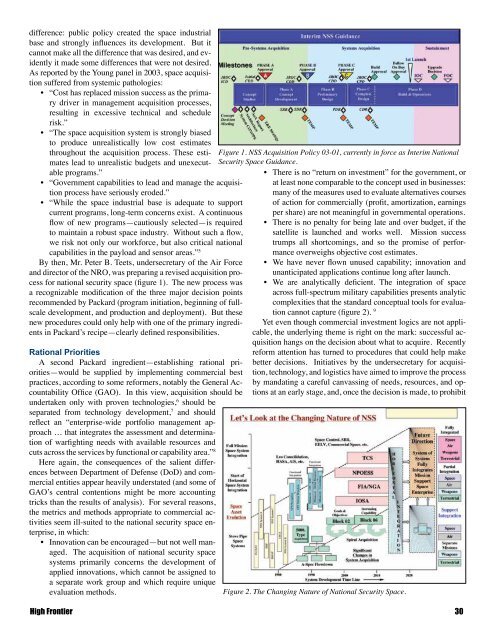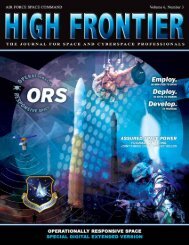Space Acquisition - Air Force Space Command
Space Acquisition - Air Force Space Command
Space Acquisition - Air Force Space Command
You also want an ePaper? Increase the reach of your titles
YUMPU automatically turns print PDFs into web optimized ePapers that Google loves.
difference: public policy created the space industrial<br />
base and strongly influences its development. But it<br />
cannot make all the difference that was desired, and evidently<br />
it made some differences that were not desired.<br />
As reported by the Young panel in 2003, space acquisition<br />
suffered from systemic pathologies:<br />
• “Cost has replaced mission success as the primary<br />
driver in management acquisition processes,<br />
resulting in excessive technical and schedule<br />
risk.”<br />
• “The space acquisition system is strongly biased<br />
to produce unrealistically low cost estimates<br />
throughout the acquisition process. These estimates<br />
lead to unrealistic budgets and unexecutable<br />
programs.”<br />
• “Government capabilities to lead and manage the acquisition<br />
process have seriously eroded.”<br />
• “While the space industrial base is adequate to support<br />
current programs, long-term concerns exist. A continuous<br />
flow of new programs—cautiously selected—is required<br />
to maintain a robust space industry. Without such a flow,<br />
we risk not only our workforce, but also critical national<br />
capabilities in the payload and sensor areas.” 5<br />
By then, Mr. Peter B. Teets, undersecretary of the <strong>Air</strong> <strong>Force</strong><br />
and director of the NRO, was preparing a revised acquisition process<br />
for national security space (figure 1). The new process was<br />
a recognizable modification of the three major decision points<br />
recommended by Packard (program initiation, beginning of fullscale<br />
development, and production and deployment). But these<br />
new procedures could only help with one of the primary ingredients<br />
in Packard’s recipe—clearly defined responsibilities.<br />
Rational Priorities<br />
A second Packard ingredient—establishing rational priorities—would<br />
be supplied by implementing commercial best<br />
practices, according to some reformers, notably the General Accountability<br />
Office (GAO). In this view, acquisition should be<br />
undertaken only with proven technologies, 6 should be<br />
separated from technology development, 7 and should<br />
reflect an “enterprise-wide portfolio management approach<br />
… that integrates the assessment and determination<br />
of warfighting needs with available resources and<br />
cuts across the services by functional or capability area.” 8<br />
Here again, the consequences of the salient differences<br />
between Department of Defense (DoD) and commercial<br />
entities appear heavily understated (and some of<br />
GAO’s central contentions might be more accounting<br />
tricks than the results of analysis). For several reasons,<br />
the metrics and methods appropriate to commercial activities<br />
seem ill-suited to the national security space enterprise,<br />
in which:<br />
• Innovation can be encouraged—but not well managed.<br />
The acquisition of national security space<br />
systems primarily concerns the development of<br />
applied innovations, which cannot be assigned to<br />
a separate work group and which require unique<br />
evaluation methods.<br />
Figure 1. NSS <strong>Acquisition</strong> Policy 03-01, currently in force as Interim National<br />
Security <strong>Space</strong> Guidance.<br />
• There is no “return on investment” for the government, or<br />
at least none comparable to the concept used in businesses:<br />
many of the measures used to evaluate alternatives courses<br />
of action for commercially (profit, amortization, earnings<br />
per share) are not meaningful in governmental operations.<br />
• There is no penalty for being late and over budget, if the<br />
satellite is launched and works well. Mission success<br />
trumps all shortcomings, and so the promise of performance<br />
overweighs objective cost estimates.<br />
• We have never flown unused capability; innovation and<br />
unanticipated applications continue long after launch.<br />
• We are analytically deficient. The integration of space<br />
across full-spectrum military capabilities presents analytic<br />
complexities that the standard conceptual tools for evaluation<br />
cannot capture (figure 2). 9<br />
Yet even though commercial investment logics are not applicable,<br />
the underlying theme is right on the mark: successful acquisition<br />
hangs on the decision about what to acquire. Recently<br />
reform attention has turned to procedures that could help make<br />
better decisions. Initiatives by the undersecretary for acquisition,<br />
technology, and logistics have aimed to improve the process<br />
by mandating a careful canvassing of needs, resources, and options<br />
at an early stage, and, once the decision is made, to prohibit<br />
Figure 2. The Changing Nature of National Security <strong>Space</strong>.<br />
High Frontier 30











